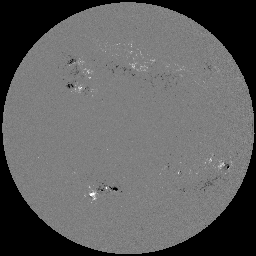 |
| Solar magnetic field |
The Solar Magnetic Field
The adjacent image shows the distribution of magnetic field on the solar surface from the Michelson Doppler Imager experiment on SOHO (January 27, 1998). Black denotes a negative polarity (magnetic field pointing into the Sun) while white denotes a positive polarity (magnetic field pointing out of the Sun). Large concentrations of both polarities are found near active regions and sunspots.The 22 Year Magnetic Cycle
The preceding considerations indicate that the Solar magnetic field has a 22 year cycle, exactly twice that of the sunspot cycle, because the polarity of the field returns to its original value every two sunspot cycles. Thus, the fundamental period governing solar activity is actually the 22 year magnetic cycle, and the sunspot cycle (which is exactly half that) is just a special manifestation of the magnetic cycle. As we shall see, the magnetic field plays an important role in most aspects of the active Sun (sunspots, prominences, flares, the solar wind, and the nature of the corona), so the 22 year magnetic cycle is central to the periodicity of the active Sun.Why are Sunspots Dark
Well, because they are cooler than the rest of the surface. But that is only a partial explanation. Why are they cooler? The answer is the strong magnetic fields associated with the sunspots.Recall that in the region below the photosphere, convective cells are largely responsible for vertical motion of large packets of gas and that this bubbling activity carries heat from the interior to the solar surface (see the discussion of granules in the photosphere). Magnetic fields exert forces on charged particles, and because this solar material is highly ionized, the magnetic fields influence the convective motion.
Detailed considerations indicate that the magnetic forces hinder the convection of heat to the surface by making it harder for the hot gases to rise. Thus, the region in sunspots having strong magnetic fields tends to be cooler than the surrounding region and thus appears darker than the surrounding regions at higher temperature.